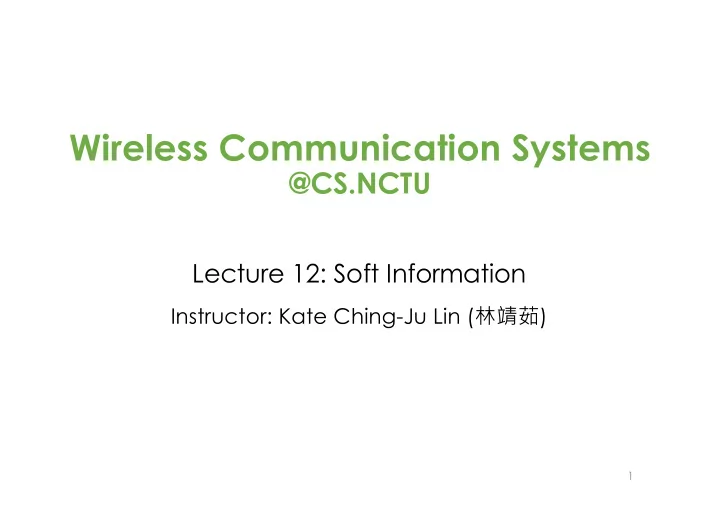

Wireless Communication Systems @CS.NCTU Lecture 12: Soft Information Instructor: Kate Ching-Ju Lin ( 林靖茹 ) 1
PPR: Partial Packet Recovery for Wireless Networks ACM SIGOCMM, 2017 Kyle Jamieson and Hari Balakrishnan CSAIL, MIT
What is Partial Packet Error? Lots of packets lost due to collisions and noise in wireless networks Non-colliding bits (P1) Non-colliding bits (P2) Time Can’t receive non-colliding bits today!
Bits in a packet don’t share fate (30 node testbed, CSMA on) Many bits from corrupted packets are correct, but status quo receivers don’t know which! 4
Three Key Questions C hecksum (P 1) (P 2) P reamble C hecksum P reamble 1. How does receiver know which bits are correct? 2. How does receiver know P2 is there at all? 3. How to design an efficient ARQ protocol? 5
Can Receiver Identify Correct Bits? : SoftPHY • Use physical layer (PHY) hints ⎻ Receiver PHY has the information! ⎻ Pass this confidence information to higher layer as a hint • SoftPHY implementation is PHY-specific; interface is PHY-independent • Implemented for direct sequence spread spectrum (DSSS) over MSK and other modulations 6
Can We Leverage Soft Info? PHY conveys uncertainty in each bit it delivers up Low uncertainty High uncertainty (P 1) P reamble (P 2) P reamble 7
Direct Sequence Spread Spectrum Transmitter: Receiver: • Demodulate MSK Data signal stream • Decide on closest 4 bits 250 Kbits/s codeword to received (Hamming distance) Bits to • Many 32-bit chip chips sequences are not valid codewords 1 codeword 2 Mchips/s (32 chips) • Codewords separated by at least 11 in MS K Hamming distance modulation • 802.11 similar
SoftPHY Hint for Spread Spectrum Hamming distance between received chips and decided-upon codeword Receive: 11101101000111000011010110100010 C 1 : 11101101100111000011010100100010 à SoftPHY hint is 2 Receive: 11001101000111010111011110110111 C 1 : 11101101100111000011010100100010 à SoftPHY hint is 9 9
Three Key Questions 1. How does receiver know which bits are correct? A: SoftPHY: (P 1) P reamble (P 2) P reamble 2. How does receiver know P2 is there at all? 3. How to design an efficient ARQ protocol? 10
Postamble decoding (P 1) (P 2) P reamble P reamble Postamble Training Training S equence Header Body Trailer T Sequence cksum EF S dst len dst len src src src F D D P reamble Postamble 11
Receiver Design with Postamble Codeword synchronization • Translate stream of chips to codewords ⎻ Search for postamble at all chip offsets ⎻ Codeword 2 Codeword 3 Codeword 1 Offset 0: Chips: 010101001010011101010001011101001010… Offset 3: Codeword 1 Codeword 2 Codeword 3 12
Three Key Questions 1. How does receiver know which bits are correct? 2. How does receiver know P2 is there at all? A: Postamble: (P 1) (P 2) P reamble P reamble Postamble Partial Packets 3. How to design an efficient ARQ protocol? 13
ARQ with partial packets ARQ today: correctly-received bits get resent • PP-ARQ key idea: resend only incorrect bits • Hamming distance 1010001101010111101101010101 Efficiently tell sender about what happened • Feedback packet ⎻ 14
Labeling Bits “good” or “bad” • Threshold test : pick a threshold h ⎻ Label codewords with SoftPHY hint > h “bad” ⎻ Label codewords with SoftPHY hint ≤ h “good” Hamming distance h 10101011010100001001010101010101 “good” “bad” 15
PP-ARQ protocol 1. Assuming hints correct, which ranges to ask for? – Dynamic programming problem – Forward and feedback channels “Good” bits 2. Codewords are in fact correct “Bad” bits or incorrect Two possibilities for mistakes • Labeling a correct codeword “bad” • Labeling an incorrect codeword “good” • 16
Implementation Sender: telos tmote sky sensor node • Radio: CC2420 DSSS/MSK (Zigbee) • Modified to send postambles [moteiv.com] Receiver: USRP software radio with 2.4 GHz RFX 2400 daughterboard • Despreading, postamble synchronization, demodulation [ettus.com] • SoftPHY implementation PP-ARQ: trace-driven simulation 17
Experimental design 25 senders • Live wireless testbed experiments 6 receivers ⎻ Senders transmit 101-byte packets, varying traffic rate ⎻ Evaluate raw PPR throughput ⎻ Evaluate SoftPHY and postamble improvements • Trace-driven experiments ⎻ Evaluate end-to-end PP-ARQ performance ⎻ Internet packet size distribution ⎻ 802.11-size preambles 18
PP-ARQ performance comparison • Packet CRC (no postamble) Preamble Checksum • Fragmented CRC (no postamble) ⎻ Tuned against traces for optimal fragment size Checksum Preamble Checksum 19
Throughput Gain: 2.3-2.8x 20
PP-ARQ Retransmissions are Short 21
25% Gain over Fragmented 22
PP-ARQ Retransmissions are Short 23
Low PP-ARQ Feedback Overhead 802.11 ACK size 24
Related work • ARQ with memory [Sindhu, IEEE Trans. On Comm. ’77] ⎻ Incremental redundancy [Metzner, IEEE Trans. On Comm. ’79] ⎻ Code combining [Chase, IEEE Trans. On Comm. ’85] • Combining retransmissions ⎻ SPaC [Dubois-Ferrière, Estrin, Vetterli; SenSys ’05] • Diversity combining ⎻ Reliability exchanging [Avudainayagam et al., IEEE WCNC ’03] ⎻ MRD [Miu, Balakrishnan, Koksal; MobiCom ’05] ⎻ SOFT [Woo et al.; MobiCom ’07] • Fragmented CRC ⎻ Seda [Ganti et al.; SenSys ’06] , 802.11 fragmentation 25
Conclusion • Mechanisms for recovering correct bits from parts of packets ⎻ SoftPHY interface (PHY-independent) ⎻ Postamble decoding • PP-ARQ improves throughput 2.3–2.8 ´ over the status quo • PPR Useful in other apps, e.g. opportunistic forwarding 26
Recommend
More recommend